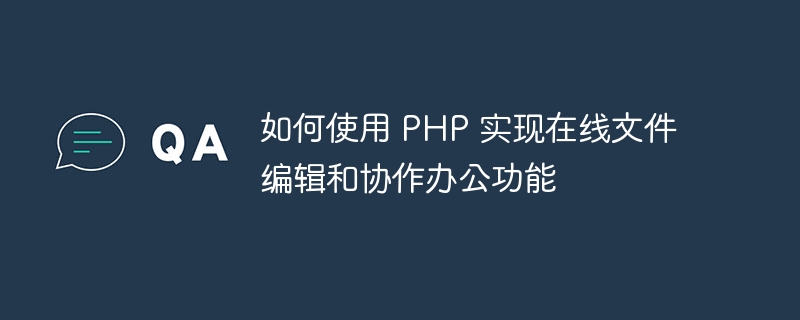Home >Backend Development >PHP Tutorial >How to use PHP to implement online file editing and collaborative office functions
How to use PHP to implement online file editing and collaborative office functions
- 王林Original
- 2023-09-06 14:28:451806browse

How to use PHP to implement online file editing and collaborative office functions
With the popularity of the Internet and the development of technology, more and more people choose to work and collaborate online , which requires a powerful and easy-to-use online file editing and collaboration system. PHP is a widely used server-side scripting language. It is good at processing web forms, file operations and interaction with databases. It is very suitable for realizing online file editing and collaborative office functions.
This article will introduce how to use PHP to implement a simple online file editing and collaborative office system. In this system, users can upload files, view file contents, edit files and save changes.
- Create a file upload function
First, we need to create a file upload function so that users can upload files to the server. You can create a file upload form using the HTML ff9c23ada1bcecdd1a0fb5d5a0f18437 tag and the 3525558f8f338d4ea90ebf22e5cde2bc tag.
<form action="upload.php" method="post" enctype="multipart/form-data">
<input type="file" name="file">
<input type="submit" value="上传文件">
</form>On the server side, we need to write a PHP script to handle file upload requests. You can use the move_uploaded_file() function to move the uploaded file to the specified directory.
<?php
$target_dir = "uploads/"; // 上传文件的保存目录
$target_file = $target_dir . basename($_FILES["file"]["name"]); // 上传文件的完整路径
if (move_uploaded_file($_FILES["file"]["tmp_name"], $target_file)) {
echo "文件上传成功";
} else {
echo "文件上传失败";
}
?>- Display file list and file content
Next, we need to create a page to display the uploaded file list and file content. You can use PHP's scandir() function to get all files in the upload directory, and use the file_get_contents() function to read the contents of the file.
<?php
$files = scandir("uploads/"); // 获取上传目录下的所有文件
foreach ($files as $file) {
if ($file != "." && $file != "..") {
echo "<a href="edit.php?file=$file">$file</a><br>"; // 显示文件名,并添加一个链接跳转到编辑页面
}
}
?>In the edit page, we can use PHP's $_GET super global variable to obtain the file parameter in the GET request parameter, and use file_get_contents( ) function reads the contents of the file and displays it on the page.
<?php
$file = $_GET["file"];
$content = file_get_contents("uploads/$file"); // 读取文件内容
echo "<form action="save.php?file=$file" method="post">";
echo "<textarea name="content">$content</textarea><br>"; // 显示文件内容的文本框
echo "<input type="submit" value="保存">";
echo "</form>";
?>- Save file modifications
Finally, we need to create a function that saves file modifications. Modified content can be saved to a file using PHP's file_put_contents() function.
<?php
$file = $_GET["file"];
$content = $_POST["content"];
if (file_put_contents("uploads/$file", $content)) {
echo "文件保存成功";
} else {
echo "文件保存失败";
}
?>Summary
Through the above steps, we can use PHP to implement a simple online file editing and collaborative office system. Users can upload files, view the file list and select files for editing, and can save file modifications after editing. Of course, this is just a simple example, and more security and functional expansions need to be considered in actual projects.
I hope this article will be helpful to you, and I wish you success in realizing online file editing and collaborative office functions!
The above is the detailed content of How to use PHP to implement online file editing and collaborative office functions. For more information, please follow other related articles on the PHP Chinese website!

